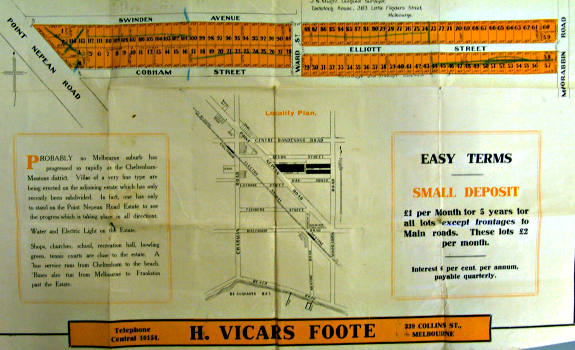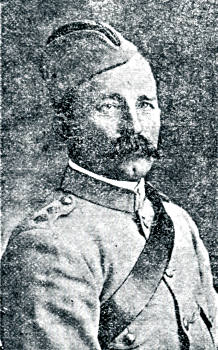The McKnights of Cheltenham

James McKnight a Cheltenham Pioneer.
James McKnight and Mary Miller were married at Paisley, Scotland in 1849, lived in Northern Ireland for a while and left there the same year to travel to England where they booked their passages to Australia, the fare being £21 each. James was born in 1819 at Lough Erne, Ireland.
The couple sailed from Plymouth on December 29, 1850 on the ship James T. Foord and arrived in Melbourne on May 2, 1851. They purchased a house in George Street, Melbourne (possibly now part of North Melbourne) and lived there for a year during which time James, in company with his wife's brother Matthew Miller, made several trips to the goldfields.
In March 1852, on one of their return trips they were attacked in the Black Forest by the Black Douglas gang of bushrangers. They escaped from this gang even though their lives were threatened. James was stuck on the head and robbed of £32 and Matthew was shot in the jaw.
George McKnight, a younger brother of James, left Ireland for England en route to Australia a few months after James and Mary. His health was poor and it was thought he might benefit from the Australian climate. He sailed from England on July 16, 1851 arriving in Melbourne on December 16, 1851 where he learned from the shipping offices that James and Mary had arrived in Melbourne in May of that year.
On December 21, 1851 George went to Geelong to work as an accountant and on Boxing Day James and Mary visited him there, having missed his arrival in Melbourne due to poor communications. They travelled to Geelong from Melbourne by steamer, a trip of seven hours.
Owing to ill health George found it necessary to resign from his position in Geelong and in April 1852 he returned to Melbourne to live with James and Mary.
In August 1852 James went to Brighton in search of land to purchase and subsequently bought approximately 20 acres fronting the Arthur’s Seat Road, now the Nepean Highway, Cheltenham. This land was bounded on the east side by what is now Warrigal Road, and on the north and south by what are now Swindon Avenue and Cobham Street respectively. This land is described in the title deeds as being part of Portion 53, Parish of Moorabbin, County of Bourke and had an area of 20 acres 2 roods 9 perches.
On September 7, 1852 James and his wife left Melbourne to make their home on the newly purchased property which they named ‘Dendron Lodge’, meaning a woody place. They were accompanied by James’ brother George and possibly by the two children already born into this family - George and Margaret. However both these children died in infancy, both certainly before 1867 and George undoubtedly before 1862.
Some arrangement was apparently made between the two brothers as the title to the land purchased was transferred on November 20, 1852 from the then owner Francis Dawe Wickham to George McKnight for the purchase price of one hundred and forty pounds. Information obtained at the Registrar Generals Office, Melbourne indicates that James McKnight, although providing the money for the purchase allowed the title to the land to be made in the name of his brother George McKnight in consideration of the latter’s state of health and the beneficial psychological effect this action should have on him. This arrangement was subject to George McKnight providing in his will that on his death the land would be devised to James McKnight. This was done and on the death of George McKnight in September 1853, the title was transferred to James McKnight.
James and Mary with others of this family group lived in tents on the property which was covered in timber and had to be cleared before a house could be built and the land used. The plans of the house were prepared by George and it was built on a rise some distance back from Arthur’s Seat Road where it was thought to be safer for a woman to be living when left alone. To provide water James and George sank a well and on December 11, 1852 water was reached at a depth of thirty two feet. It was good water but slightly brackish.
More land was cleared and the wood sold for nine shillings and sixpence per load, delivered. Fences were made from timber on the property, and the property was fully fenced by 1858. Dry seasons led to failure of the earlier crops but as more experience of local weather conditions was gained more success was achieved and good results were obtained. The land proved very suitable for agricultural purposes, cows and poultry were raised and an orchard planted comprising apples, pears, plums cherries, quinces, figs, mulberries and almonds.
A third child, William, was born on May 16, 1853. Only a few months later, on September 20, 1853, James’ brother, George died. He was buried in the grounds of St. Andrew’s Church of England at Brighton, Victoria. Six other children were born into the family of James and Mary, the next being Catherine Ann, in 1856, who was to marry William Walker and later lived in South Melbourne.
A son James was born next but died in infancy. Isabella was born in 1859 and subsequently married Harry Booker. George (the second given that name) was born in 1862 and married Jane Smithies in 1886; more of him is recorded later, Mary Ann was born in. 1865 and later married Arthur Brown. Lastly another son, given the name of James, was born but he also died in infancy.
Mary McKnight apparently suffered from tuberculosis of the lungs, a condition which persisted for ten years, and she died on April 13, 1867.
James McKnight was thus left with a family of five children, the eldest being fourteen and the youngest two years of age.
James had taken an active interest in public affairs. He was one of the founders of the Mechanics Institute at Cheltenham and had been made a Trustee in April 1864. He had attended the opening of the Court of Petty Sessions on September 15, 1865 which was held at the Institute.
He was a pioneer worker of the Church of England and attended services in the original building used for that purpose and later in St. Matthew’s Church in Point Nepean Road (later renamed Nepean Highway). The church was opened on April 14, 1867 and his name is on the Scroll inserted in the foundation stone of the original church building.
James, although now with increased family responsibilities because of the death of his wife, continued his interest in the affairs of the district and remained a Trustee of the Mechanics’ Institute until 1901 when he resigned due to failing health. He died on August 5, 1902 at the age of 83. He had built another house on the Dendron Lodge property but this time nearer the Highway, one that was to be used by members of his family for many years to come.
James McKnight had arranged for the land he had acquired at Cheltenham to be brought under the Transfer of Land Act which was brought into operation in 1890 and a Certificate of Title under that Act was issued to him on February 20, 1897.
The property comprising land containing 20 acres 2 roods 9 perches being part of Portion 53, Parish of Moorabbin, County of Bourke was bequeathed by James McKnight to his son William during his natural lifetime but with the proviso that he should not sell or dispose of the property. After the death of William the land concerned was to become the property of his children, share and share alike, or, if no such children, his (William’s) brothers and sisters or their children.
In a further codical to the will James McKnight provided that, after the death of his son William, his (William’s) widow (if any) should have the use and enjoyment of the property during her lifetime so long as she did not remarry and that after her death the property was to be sold and the proceeds divided between the children of William, share and share alike, but if there were no such children divided between the brothers and sisters of William McKnight, or their children.
The terms of the lease of the Cheltenham property to George Matthew Miller McKnight are not known but George and his family continued to live on the property for many years even while the title to the land remained in the name of William McKnight or was held on his behalf.
In November 1926 the title to this land was transferred to Hedley Vicars Foote and Rupert Vicars Foote, presumably a firm of’ solicitors to hold the land in trust for William McKnight, and who arranged for registration of a subdivision of the land into residential allotments and for the disposal of these allotments after the death of William McKnight in the early 1930’s.

Sale of the Point Nepean Road Estate, Cheltenham, c1930.
In his early years William McKnight had developed an interest in military affairs and participated in the activities of ‘D’ Company of the Victorian Rangers, the majority of the members of this unit enlisting with him for service in South Africa during the Boer War. Initially he was enlisted as Captain and Adjutant of the Third (or Bushman’s) Contingent for Service in South Africa, this unit comprising two companies of mounted rifles.
Promoted to the rank of Major, William McKnight was with the Fifth Victorian Mounted Rifles in eastern Transvaal and as senior Victorian officer with that unit had occasion to send reports direct to the Australian Prime Minister on its activities.

Lt William McKnight 1901.
After returning from South Africa William McKnight, now promoted to Lieutenant Colonel, married Isabella McColl about the year 1903 and had two son, Duncan and Hugh. He retired from active military service in 1910 and died about 20 years later at the age of 80 years.
George Matthew Miller McKnight, the second of two sons given the name George (the first died in infancy) worked as a gardener for many years and at the age of 24 years married Jane Smithies, also 24 years of age, at the home of George’s sister Catherine in Palmerston Crescent, South Melbourne, on April 29, 1886. Witnesses at the wedding service were William McKnight the bridegroom’s brother and Emma Smithies the bride’s sister.
George and Jane had eight children, seven daughters and one son. Of the daughters, Helen, the second eldest, married Robert Matthew Kellett, whilst the third and second youngest daughters, Isabel and Gladys, married George Morgan and Sydney Eric Chandler respectively. The only son, James, married Amelia Baker.
George and Jane McKnight lived for much of their married life at Dendron Lodge, from which George conducted a carrying business. George died in October 1940 and his wife Jane in February 1947. Three of their daughters lived on in the house ‘Dendron Lodge’ until 1966 when it could no longer be kept in repair, and the property was sold.
